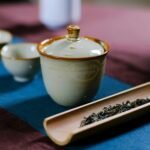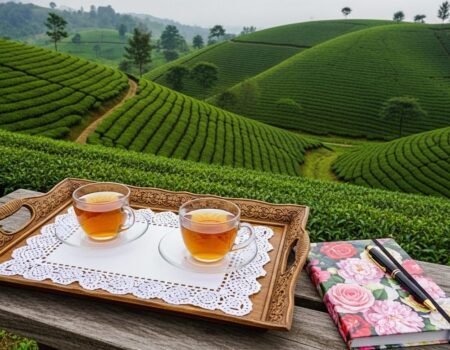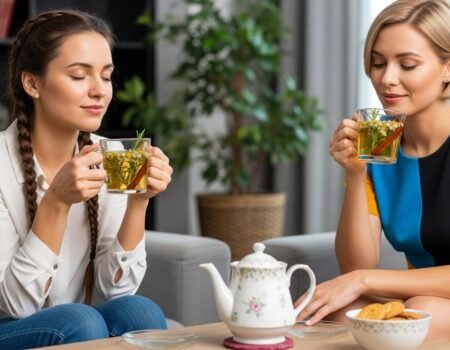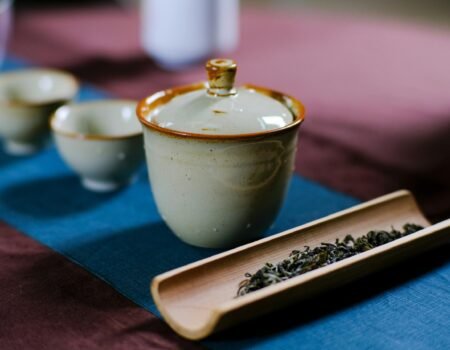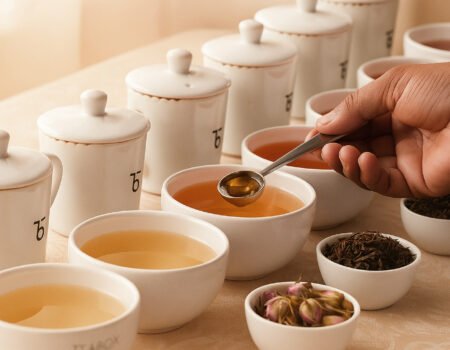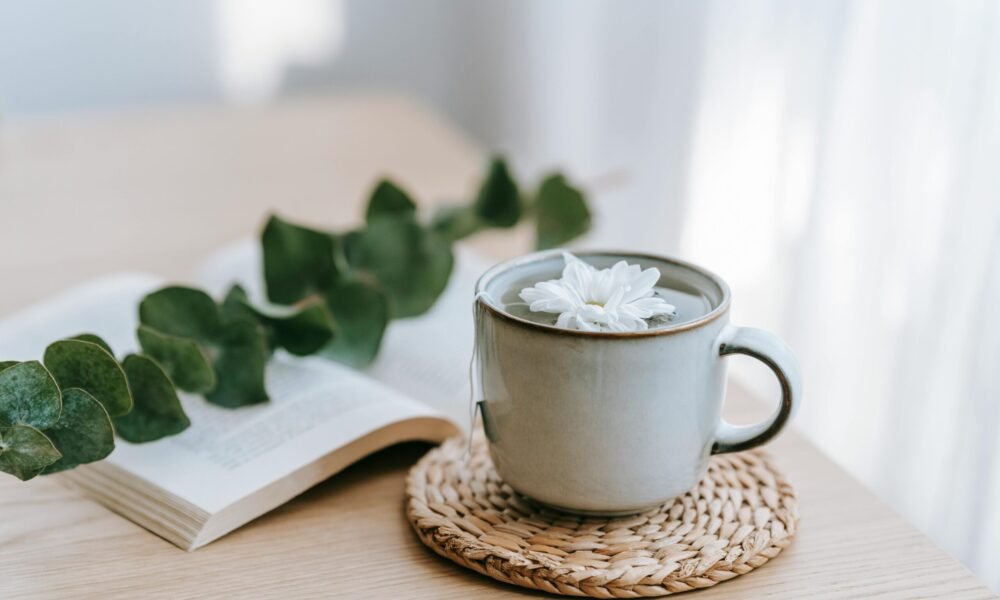
Mastering Tea Tasting Vocabulary: A Guide to Describe Tea with Precision
Index
Do you struggle to find the right words when describing the tea you drink? Tea tasting vocabulary helps bridge the gap between what you taste and how you express it. Learning proper tea terms will sharpen your senses and let you share your tea experiences with clarity.
This guide will build your tea language skills from basic to expert level. Ready to transform how you talk about tea?
Key Takeaways
- Tea tasting vocabulary includes 37 distinct attributes—24 for flavor and 13 for aroma—giving tasters precise tools to describe each cup.
- Dry leaf appearance reveals quality markers through terms like “Black” (desirable), “Bloom” (proper processing), and “Tip” (fine plucking standards).
- Common off-flavors include “Baggy” (from poor storage), “Burnt” (over-fired), and “Moldy” (from damp conditions), which help identify low-quality teas.
- Tea liquor quality shows through traits like “Bright” (lively character), “Brisk” (active taste), and “Muscatel” (grape-like notes found in Darjeeling teas).
- Learning flavor categories such as floral, fruity, nutty, smoky, and vegetal helps tea drinkers communicate their experiences with greater precision.
Understanding the Core Tea Tasting Lexicon
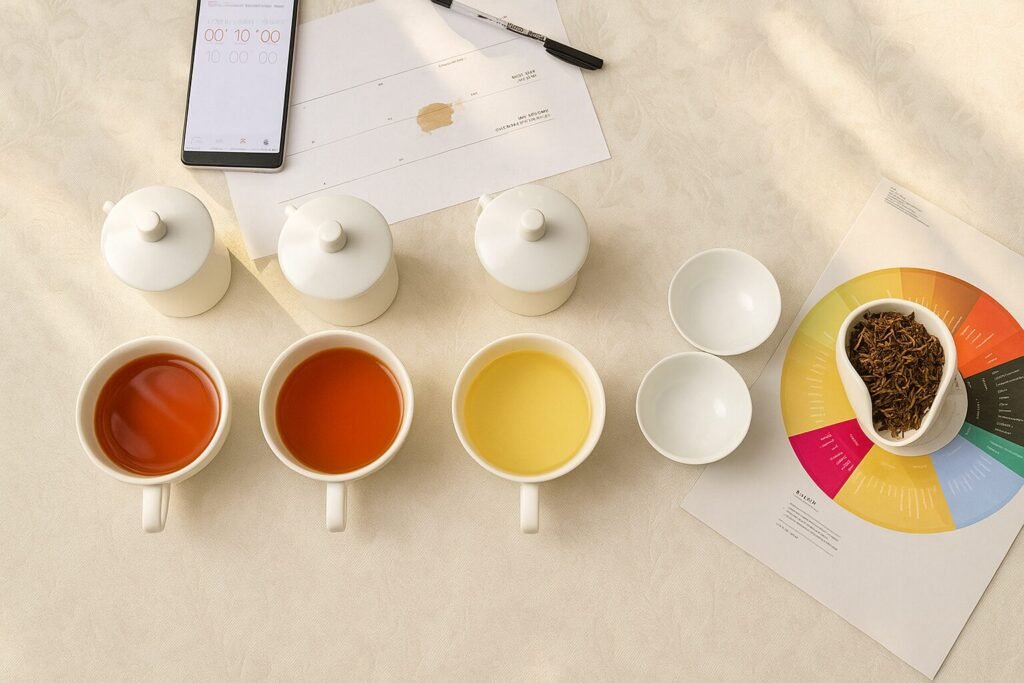
Tea tasting starts with learning the basic words experts use to talk about tea. A strong lexicon helps you spot the difference between a grassy green tea and a muscatel Darjeeling with precision.
General Sensory Descriptors
General sensory terms form the backbone of tea tasting vocabulary. These descriptors include aroma (the scent that rises from the cup), astringency (the dry, puckering feeling on your tongue), body (the weight and substance in your mouth), and finish (the lasting impression after swallowing).
Certified Tea Master Alison Dillon points out that learning these basic terms helps beginners build confidence in expressing what they taste. The sensory lexicon for tea contains 37 distinct attributes—24 for flavor and 13 for aroma—giving tasters precise tools to capture each cup’s character.
Tea experts use specific terms like “bright” for teas with refreshing qualities and “muscatel” for flavors reminiscent of grapes, often found in Darjeeling teas. The mouthfeel might be described as “smooth,” “soft,” or “thick” depending on how the liquid coats your palate.
Statistical analyses such as ANOVA and PCA help professionals visualize relationships between different tea samples and their sensory profiles. Mastering these core descriptors allows you to identify subtle nuances in various teas and communicate your experience with greater precision.
Describing Dry Leaf Characteristics
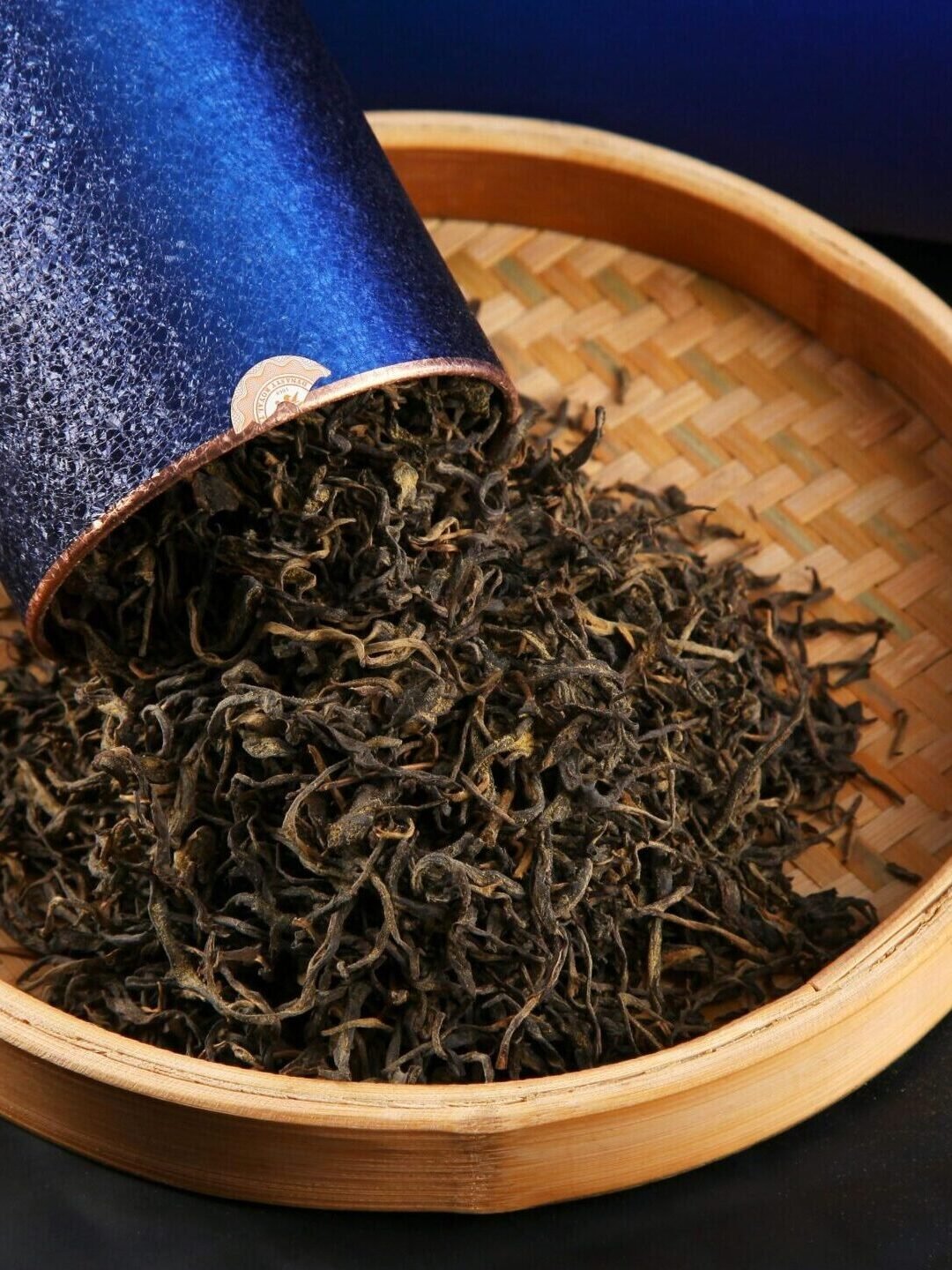
Beyond basic sensory terms, tea experts pay close attention to dry leaf characteristics. These visual clues reveal much about a tea’s quality and processing methods. Dry leaves speak volumes through their appearance, with terms like “Black” indicating desirable quality and “Blackish” showing satisfactory results in CTC or LTP teas.
A good “Bloom” signals proper manufacture and sorting, showing up as a pleasant sheen on well-processed leaves.
Tea leaves should appear “Clean” without fibers, dust, or foreign matter. Watch out for “Musty” leaves, which point to mildew problems. The presence of “Tip” in Orthodox grades suggests fine plucking standards.
Other important descriptors include “Bold,” “Curly,” “Even,” and “Well Twisted” for shape, while “Wiry” and “Chunky” describe the leaf structure. These visual markers help tea drinkers assess quality before brewing even begins.
Describing Infused Leaf Characteristics
Moving from dry leaf assessment to infused leaf evaluation reveals crucial quality markers in tea. Infused leaves tell a detailed story through their aroma and appearance. Tea experts examine these wet leaves for brightness, color uniformity, and specific scents that signal proper processing.
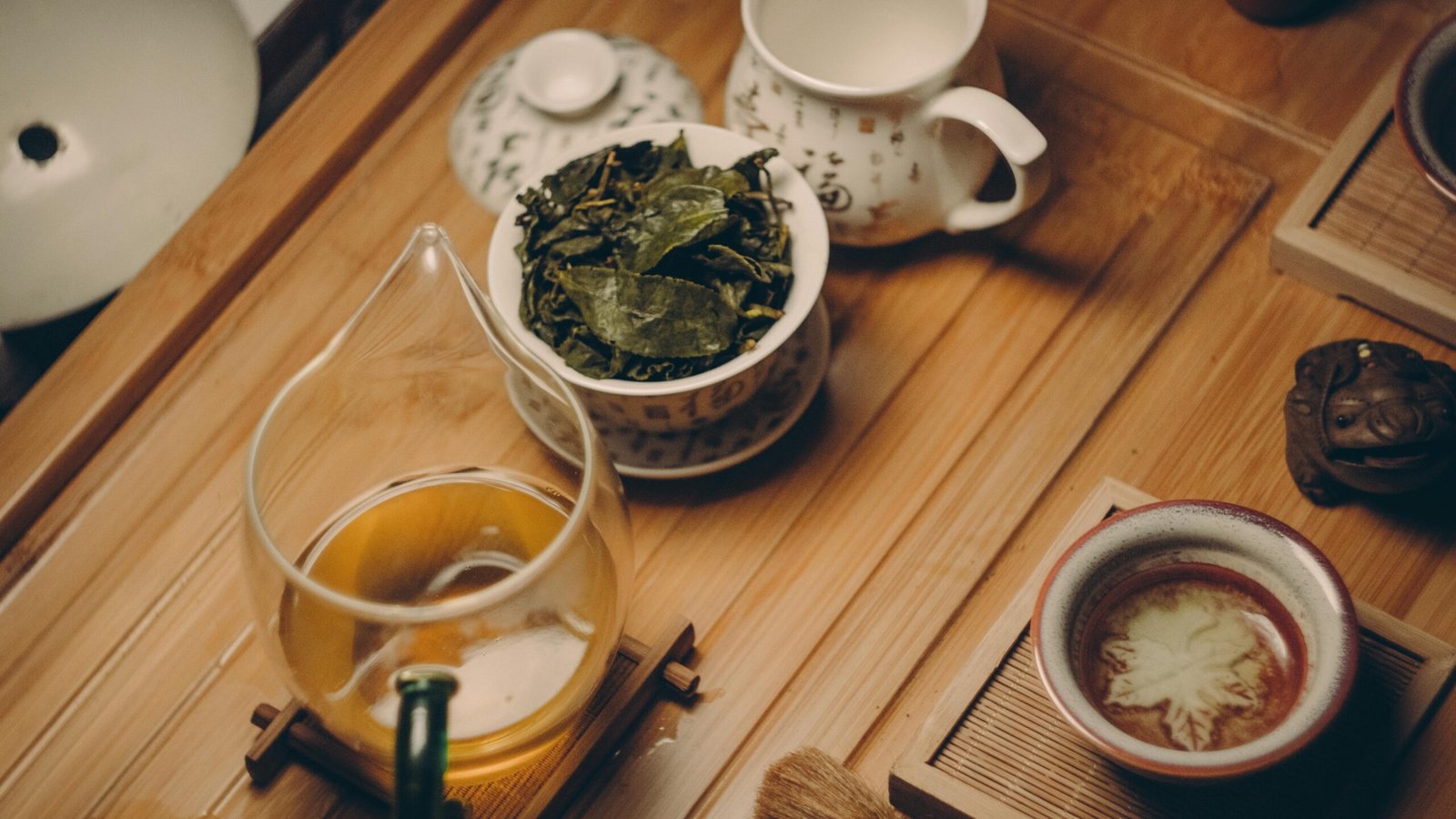
Bright, coppery leaves typically indicate well-manufactured tea with proper fermentation levels.
Leaf appearance after steeping provides clear signals about tea quality. Dull leaves often point to poor manufacturing methods or excessive moisture content. Green-tinged infused leaves suggest under-fermentation or use of immature tea bushes.
Tarry notes in the wet leaves reveal smoky aromas that might come from the firing process. These visual and aromatic traits help tea tasters judge a tea’s craftsmanship before they even taste the liquor.
Key Flavor and Aroma Categories in Tea
Tea offers a vast range of flavors and aromas that create its unique character. Learning these key taste groups will sharpen your ability to spot subtle notes in each cup.
Floral and Fruity Notes
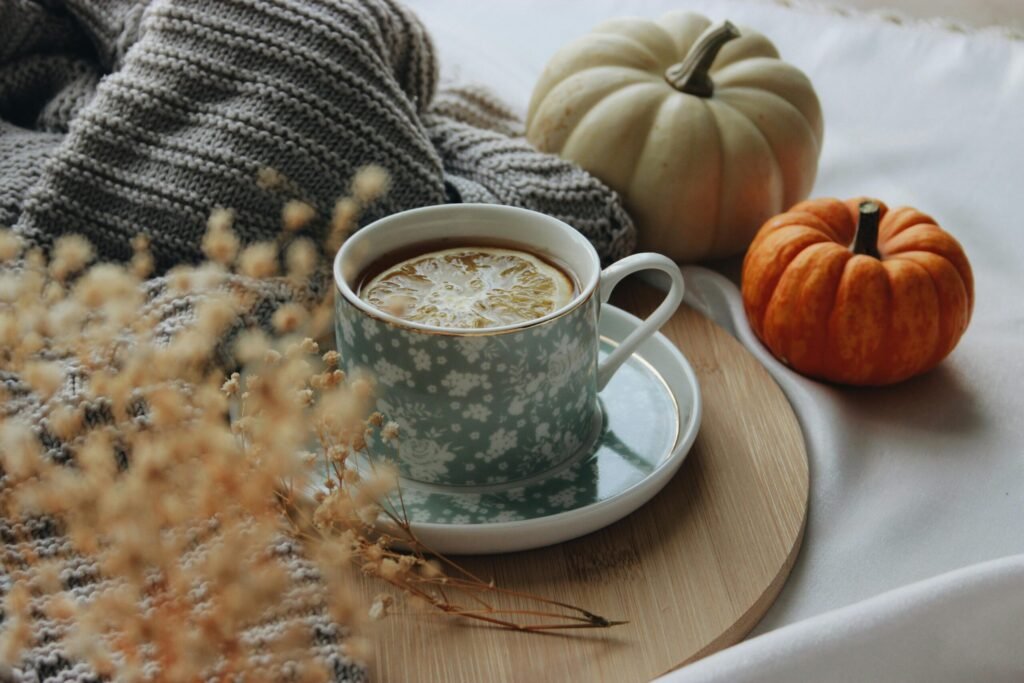
Floral notes stand as a hallmark of premium tea quality, often detected in white teas through their sweet, fragrant character. These delicate aromas might remind you of jasmine, rose, or orchid, creating a pleasant sensory experience that tea connoisseurs prize.
Fruity notes appear commonly in black teas, offering hints of citrus, stone fruits, or berries that add depth to the cup’s flavor profile. The ability to spot these distinct characteristics enhances your tasting skills and deepens your tea appreciation.
Expert tea tasters pay close attention to fruity flavors as they sometimes signal problems in processing. Over-fermentation or bacterial growth before firing can create unwanted fruity notes that differ from the natural fruit characteristics found in properly processed teas.
The next section explores nutty, buttery, and sweet notes that further expand your tea vocabulary.
Nutty, Buttery, and Sweet Notes
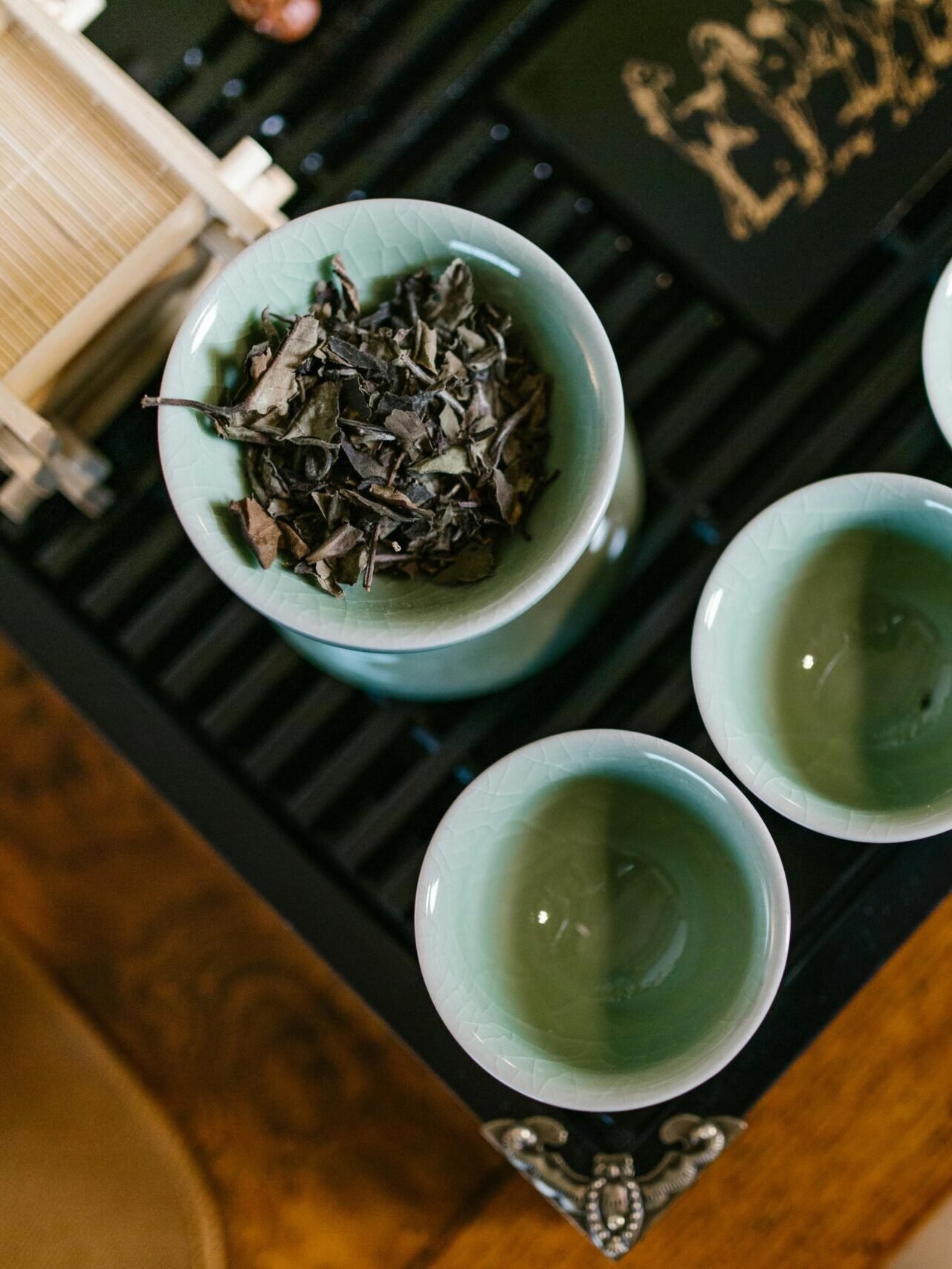
Nutty flavors bring depth and warmth to many teas, ranging from light almond hints to rich chestnut fullness. These notes appear most often in roasted oolongs and aged black teas, creating a cozy, comforting taste profile.
Buttery notes add a smooth, creamy texture that coats the mouth—particularly noticeable in high-quality oolong varieties that offer a velvety mouthfeel. The natural sweetness in tea exists on a spectrum from subtle honey-like qualities to more distinct caramel or toffee notes that balance any astringency.
Your personal taste plays a major role in how much you enjoy these flavor elements. Some tea lovers seek out the rich, toasty notes of a well-fired tea, while others prefer the gentle sweetness found in certain green teas.
Learning to spot these flavor markers helps build your tea vocabulary and deepens your appreciation of each cup’s unique character. The spicy and smoky notes in tea offer another dimension of complexity worth exploring in your tasting journey.
Spicy, Smoky, and Oceanic Notes
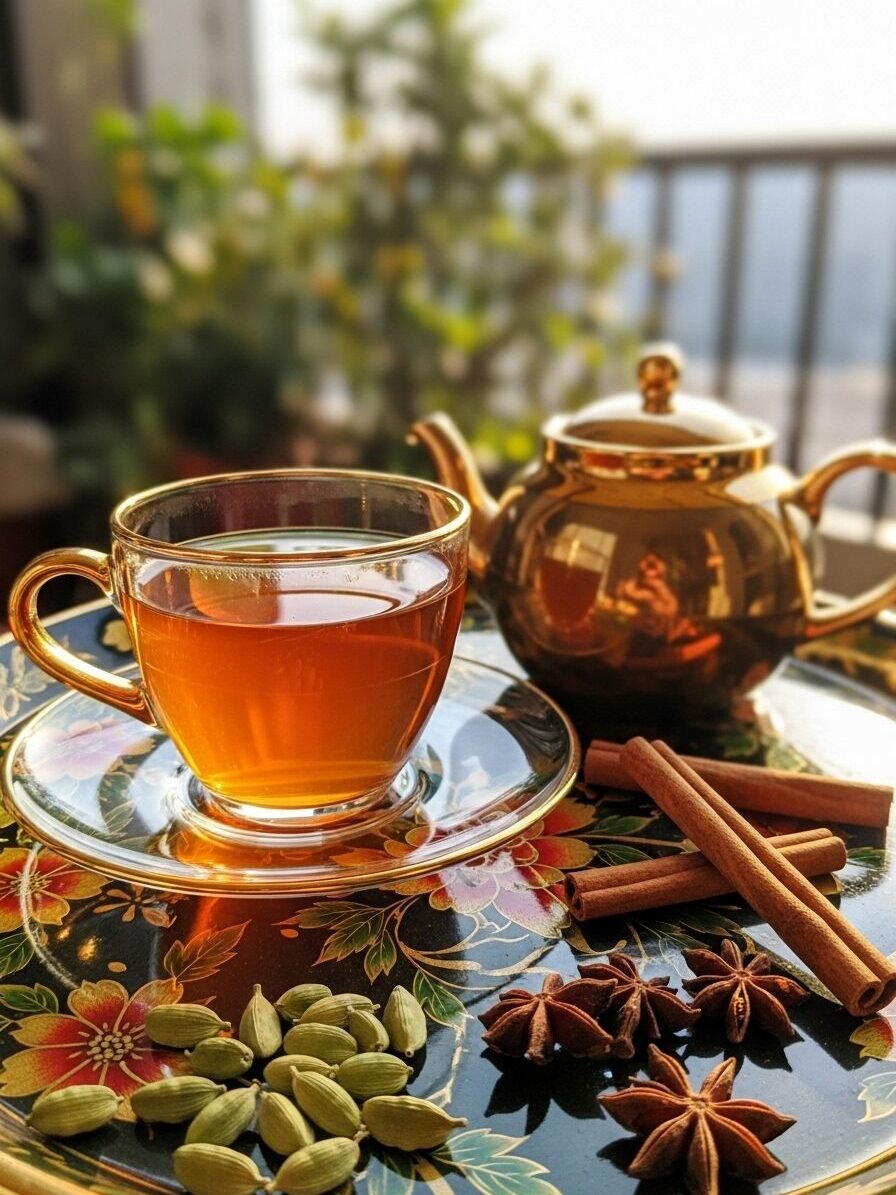
Spicy notes bring warmth and character to many teas, most notably in Chai blends where cinnamon, cardamom, and ginger create distinct flavor profiles. Smokey flavors define Lapsang Souchong tea with its pine-smoke aroma, though this quality can signal problems with tea dryers when found in other varieties.
Tea experts often check for this trait during quality assessment to spot potential processing issues.
Japanese green teas stand out for their oceanic qualities that remind drinkers of sea breezes or fresh seaweed. These marine notes come from the unique growing conditions near coastal areas and specific processing methods.
The combination of these three flavor categories helps tea tasters create a complete vocabulary to describe complex taste experiences with precision. Each note serves as an important marker in the tea’s overall flavor story.
Vegetal, Earthy, and Mineral Notes
Green teas showcase distinct vegetal notes that tea lovers often describe as grassy or herbaceous. These fresh flavors give green tea its bright, lively character in the cup. The liquor carries these plant-like traits that reflect the tea’s minimal oxidation process.
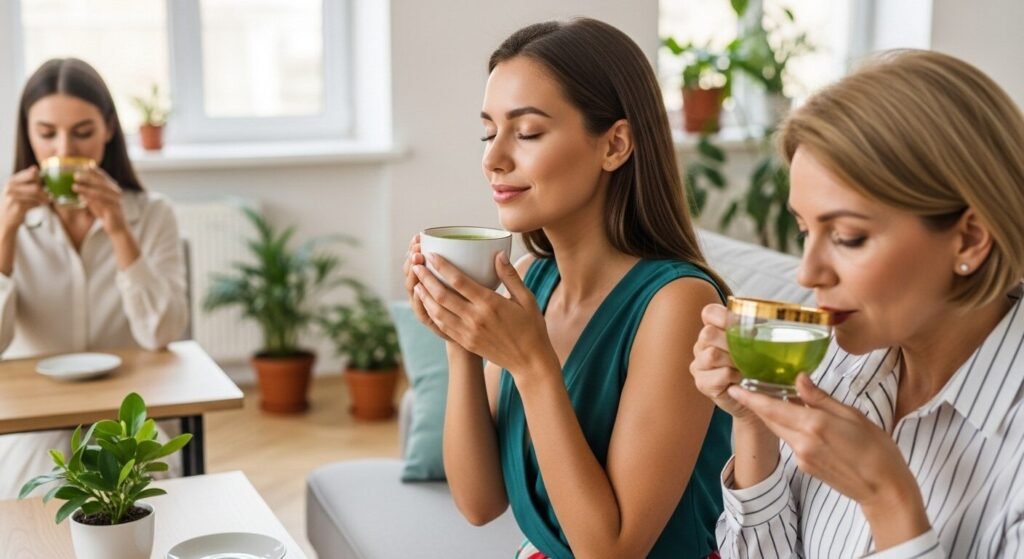
Black teas, in contrast, develop earthy notes that create a rich, robust flavor profile. These earthy qualities might come from specific growing regions or result from storage conditions with high moisture content.
The infusion shows depth and substance that fills the mouth with each sip.
Mineral notes add complexity to many oolong varieties, creating a refreshing quality that balances other flavor components. These notes might appear as a slight saltiness or stone-like taste that lingers on the palate.
The interaction between polyphenols in tea and proteins in saliva affects how we perceive these mineral characteristics. Tea tasters often note how these flavors develop from the front to the back of the mouth during tasting.
Next, we’ll explore how to identify common faults and negative attributes that might appear in tea.
Identifying Faults and Negative Attributes in Tea
Even expert tea drinkers need to spot flaws in their brews. Learning to detect common taints and faults will help you avoid poor quality teas and improve your brewing skills.
Common Off-Flavors and Taints
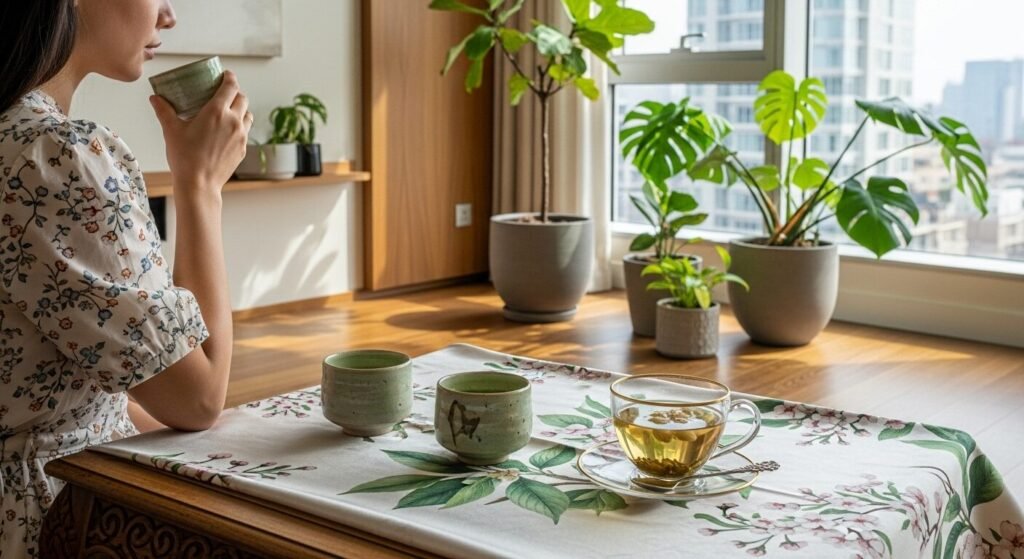
Tea tasting requires a sharp sense for spotting flaws in your brew. Learning to spot these unwanted flavors helps you choose better teas and understand quality issues.
- Baggy – This taint comes from tea stored in unlined hessian bags, giving the tea a musty, rope-like flavor that ruins the true taste profile.
- Burnt – Extremely over-fired tea develops a harsh, charred taste that overwhelms other flavor notes and creates an unpleasant pungency on the palate.
- Fruity (Sour) – While fruity notes can be positive, an overly sour or fermented fruit taste often signals bacterial issues before firing or poor storage conditions.
- Green – An immature, raw character appears in tea from under-fermentation or withering problems, creating a grassy harshness rather than proper development.
- Metallic – Sharp, coppery flavors create an unpleasant mouth reaction between polyphenols and saliva proteins, often found in poorly processed teas.
- Smokey – Unless intended (as in Lapsang Souchong), a smoky taste typically indicates faulty firing techniques or contamination during processing.
- Weedy – This off-flavor resembles dried hay or weeds, lacking brightness and proper aroma compounds that should develop during correct processing.
- Stale – Tea loses its vibrant olfactory properties over time, resulting in flat liquor that lacks substance in the mouth and shows dull color.
- Moldy – Poor storage conditions create musty, damp basement notes that completely mask the tea’s intended flavor profile.
- Coarse – This texture fault creates a rough mouth feel rather than the supple, round sensation found in properly processed teas.
Textural and Appearance Faults
Tea quality depends greatly on visual and textural aspects that signal freshness and proper processing. Spotting these faults helps you avoid disappointing brews and select only the finest teas for your collection.
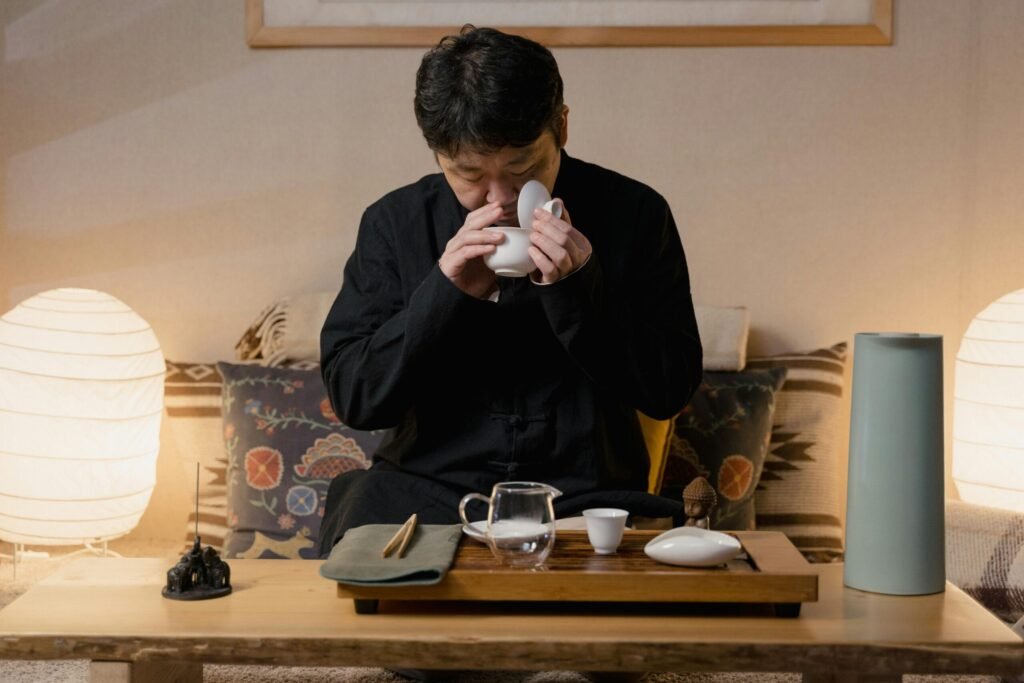
Visual Quality Markers
These characteristics are immediately visible when you examine dry tea leaves:
Color and Appearance Issues
- Dull appearance – Infused leaves should maintain vibrant color after steeping. Dullness points to poor quality leaves that have lost their essential oils and flavor compounds
- Faded color – Fresh tea leaves should display rich, natural colors specific to their type. Fading suggests aging or light damage that diminishes both flavor notes and aroma
Leaf Structure Problems
- Irregular shapes – Quality tea maintains consistency in leaf size and form. Irregular pieces point to careless processing that affects the tea’s weight and substance in your cup
- Uneven leaf distribution – Poorly sorted leaves create an unbalanced brew where some parts may steep faster than others, often resulting in bitter patches throughout your tea liquor
Physical and Textural Faults
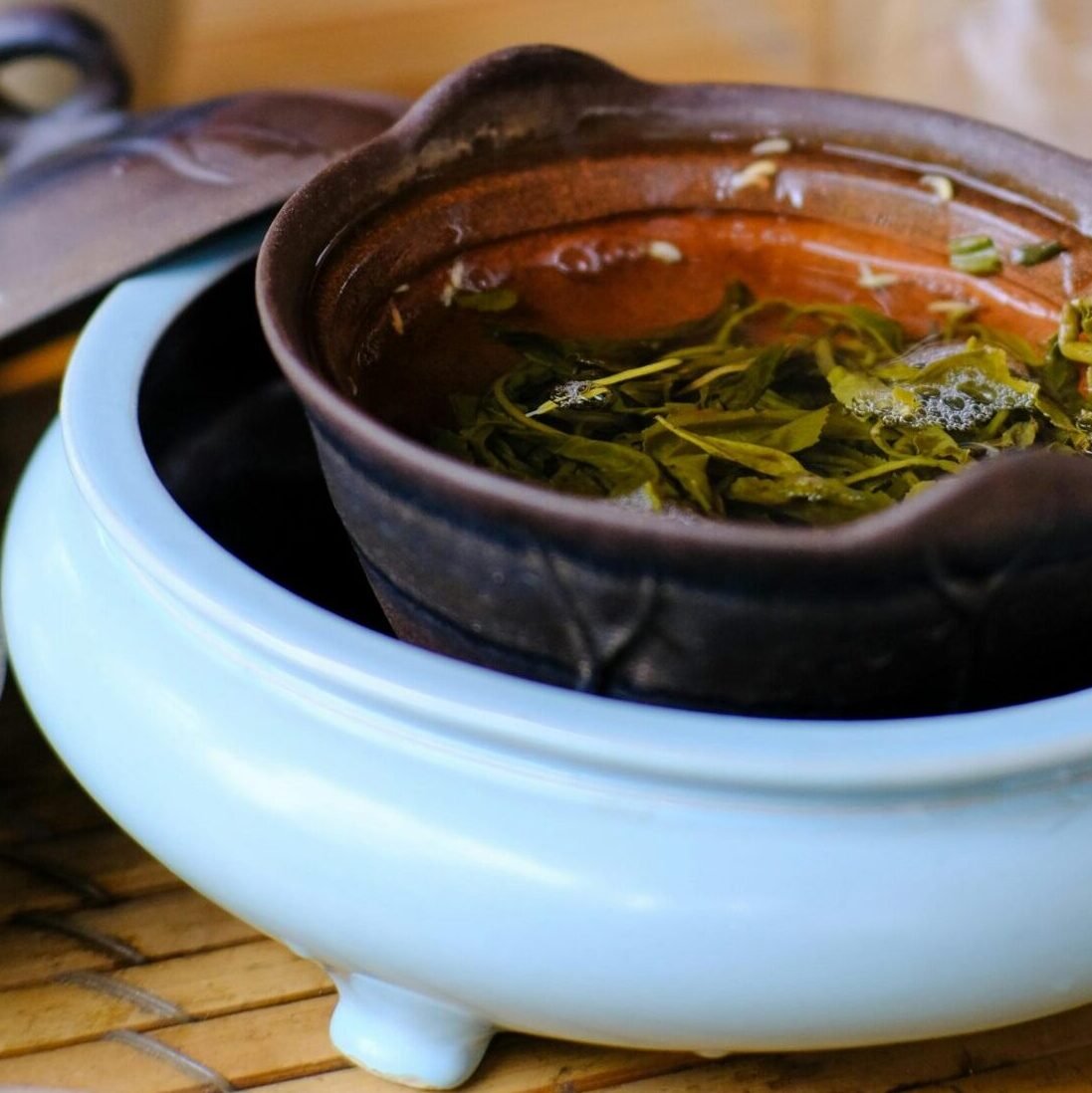
You can detect these issues through touch and close examination:
- Flaky leaf texture – Open and light texture signals improper processing or storage conditions. Flaky leaves typically produce a thin cup lacking the roundness and depth prized by tea experts
- Dusty residue – Fine powder at the bottom of tea containers indicates broken leaves or poor handling. These particles can make your brew cloudy and add unwanted astringency
- Stem abundance – Excessive stems mixed with leaves create an unbalanced brew. Too many woody elements dilute the true character of the tea liquor
Storage and Freshness Indicators
These signs reveal problems with how the tea was stored or its current condition:
- Gone off signs – Flat taste profiles result from excessive moisture content during storage. This fault creates a lifeless cup that lacks brightness and vigor in the mouth
Next, we’ll explore how to describe the color and specific characteristics of tea liquor with precision and confidence.
Describing Liquor Color and Specific Characteristics

Tea liquor reveals its quality through distinct visual and taste features. A “bright” tea displays a lively character with a reddish hue that signals freshness and proper processing.
“Brisk” teas offer a live, active taste that awakens the palate rather than falling flat. You’ll notice “coloury” teas by their deep, rich shade that often points to strength and full body.
Tea experts avoid “muddy” liquors, which lack clarity and suggest poor leaf quality or incorrect brewing methods.
The famous “muscatel” flavor stands as a prized trait in fine Darjeeling teas, creating grape-like notes that tea lovers seek worldwide. This rare quality appears mostly in second-flush Darjeelings harvested in summer months.
“Pungent” describes teas that combine astringency with briskness, brightness, and strength – a complex mix that creates an immediate impact on the tongue. These terms help you pinpoint exactly what makes each cup special and build your skill in tea assessment.
Conclusion

Mastering tea vocabulary transforms your tasting experience from simple sips to rich sensory journeys. Your ability to identify floral notes in oolong or detect astringency in black tea connects you with centuries of tea culture.
This precision helps you communicate with other enthusiasts and select teas that match your exact preferences. The language of tea tasting opens doors to deeper appreciation, whether you’re describing a bright Darjeeling or a vegetal green tea.
Armed with these descriptors, you’ll enjoy each cup with greater awareness and find new depths in every brew.
For a deeper dive into how to professionally assess tea quality, check out our guide on tea cupping methods.
Quick Reference: A Glossary of Tea Tasting Terms
Positive Attributes
| Term | Description |
|---|---|
| Aroma | The scent or smell that rises from the brewed tea. |
| Astringency | The dry, puckering sensation on the tongue, caused by tannins. A desirable trait when balanced. |
| Black / Blackish | A desirable dark color in dry CTC or LTP tea leaves, indicating good quality. |
| Bloom | A pleasant sheen on the surface of dry tea leaves, signaling proper manufacture and sorting. |
| Body | The weight, substance, and feeling of the tea in your mouth (e.g., light, medium, full). |
| Bright | Describes both infused leaves (coppery) and liquor (reddish hue), indicating a lively, fresh character from proper processing. |
| Brisk | A live, active taste that awakens the palate; the opposite of flat or soft. |
| Buttery | A smooth, creamy texture and flavor that coats the mouth, often found in high-quality oolongs. |
| Clean | Refers to dry leaves that are free from dust, fibers, or any foreign matter. |
| Coloury | Describes a tea liquor with a deep, rich color, often indicating strength and a full body. |
| Earthy | A rich, robust flavor profile reminiscent of soil or wet earth, common in black teas like Pu-erh. |
| Finish | The lasting impression and flavor notes that remain on the palate after swallowing the tea. |
| Floral | Sweet, fragrant notes reminiscent of flowers like jasmine, rose, or orchid. A hallmark of premium tea. |
| Fruity | Flavor notes of citrus, stone fruits, or berries. Common in black teas and adds depth. |
| Mineral | A refreshing quality with a slight saltiness or stone-like taste, adding complexity to oolongs. |
| Muscatel | A prized, rare grape-like flavor found in fine Darjeeling teas, especially from the second flush. |
| Nutty | Warm, comforting notes ranging from light almond to rich chestnut, often in roasted oolongs. |
| Oceanic | Marine notes reminiscent of sea breezes or seaweed, characteristic of many Japanese green teas. |
| Pungent | A powerful combination of astringency, briskness, brightness, and strength. |
| Smoky | A desirable pine-smoke aroma and flavor, the defining characteristic of Lapsang Souchong. |
| Spicy | Warm, distinct flavor notes from spices like cinnamon, cardamom, or ginger, prominent in Chai. |
| Sweet | Natural sweetness ranging from subtle honey to distinct caramel or toffee notes. |
| Tip | The presence of unopened leaf buds in Orthodox grades, suggesting fine plucking standards. |
| Vegetal | Fresh, grassy, or herbaceous notes, characteristic of green teas due to minimal oxidation. |
| Well Twisted / Wiry | Describes dry leaves that are tightly rolled, indicating good withering and processing. |
Negative Attributes (Faults)
| Term | Description |
|---|---|
| Baggy | A musty, rope-like taint from tea stored in unlined hessian bags. |
| Burnt | A harsh, charred taste from tea being extremely over-fired during drying. |
| Coarse | A rough mouthfeel, lacking the supple, round sensation of well-processed tea. |
| Dull | Describes infused leaves or liquor lacking brightness, indicating poor quality or staleness. |
| Fruity (Sour) | An undesirable fermented or sour fruit taste, often signaling bacterial issues or poor storage. |
| Gone Off / Stale | A flat taste and lack of vibrant aroma, resulting from age or excessive moisture during storage. |
| Green | An immature, raw, grassy harshness resulting from under-fermentation or withering problems. |
| Metallic | A sharp, coppery flavor creating an unpleasant mouth reaction. |
| Moldy / Musty | Damp basement notes from poor storage in humid conditions, indicating the presence of mildew. |
| Muddy | Describes a tea liquor that lacks clarity, suggesting poor leaf quality or improper brewing. |
| Weedy | An off-flavor resembling dried hay or weeds, lacking the proper aroma and brightness. |
FAQs
1. What is tea tasting terminology?
Tea tasting terminology is the special vocabulary used to describe tea flavors, aromas, and qualities. These words help tea lovers communicate the complex tastes and sensations found in different teas. The glossary of terms ranges from basic descriptors to advanced vocabulary that captures subtle notes.
2. How do I describe the astringency in tea?
Astringency refers to the dry, puckering effect on the tongue and mouth after tasting tea. It happens when tannins in tea bind with proteins in saliva. You might call a tea “tannic” or “astringent and lively” when this quality is strong.
3. What does “bakey” mean when describing tea?
“Bakey” is an undesirable term that denotes a tea with flavors similar to baked goods that have been overcooked. This descriptor often points to problems in tea processing that harm the natural taste.
4. How is wine terminology related to tea tasting?
Many tea descriptors borrow from wine vocabulary, especially when discussing aroma or “nose.” Terms that describe phenolic content (bitter-astringent compounds such as catechins and tannins), temperature effects (how steeping or serving heat shifts aroma release and sweetness), and spice notes (clove-, cinnamon-, or pepper-like aromas from leaf chemistry or firing) cross over between both worlds. The concept of “finish” or aftertaste applies similarly to both beverages.
5. What does “mouthfeel” refer to in tea tasting?
Mouthfeel describes the tea’s weight and substance as you drink it. It’s immediately felt in the mouth and can range from light to full-bodied. This quality helps tea experts assess overall character and is commonly used alongside flavor notes to create a complete profile.
6. How can I learn to identify specific flavors in tea?
Start with basic flavors like sweet, bitter, and astringent that are easy to spot. Practice with different tea types from China and other regions to build your palate memory. Compare notes with other tea enthusiasts and use established tea leaf grading systems as guides to understanding quality markers.
References
- https://pmc.ncbi.nlm.nih.gov/articles/PMC6342540/
- https://www.stashtea.com/blogs/education/tea-tasting-glossary
- https://www.teacupsfull.com/blogs/tea-blog/tea-tasting?srsltid=AfmBOoqU5LFhof8iSkTe3Osr–B7d9ER3ppi7PtC6ibHPcCYnZ_Md1vb
- https://artfultea.com/blogs/tea-wisdom/what-does-tea-taste-like-a-guide-to-tea-tasting-notes?srsltid=AfmBOoo-7O1wP4njsJgaLl3JS_7HKNY-hcPOV1j6s8UozgOj-hRMu2Il
- https://artfultea.com/blogs/tea-wisdom/what-does-tea-taste-like-a-guide-to-tea-tasting-notes?srsltid=AfmBOoqDdPO5C01hegUHoyXyi6H8pOK2dE28dU5mmyc-SJbn1LnruPzM
- https://jyyna.co.uk/tea-taste/
- https://pathofcha.com/blogs/all-about-tea/tasting-tea-like-a-pro-a-detailed-guide?srsltid=AfmBOop2hI3Y3GgGaR8PI-K5CdJFd82pZ1Xf2IduXD1xDvaSf3qtbIAN
- https://artfultea.com/blogs/tea-wisdom/what-does-tea-taste-like-a-guide-to-tea-tasting-notes?srsltid=AfmBOoqQcGL7o7hTmPiPBmBpaH_oa63wING8PMcu8flxYAJ3cm6f9HtR
- https://www.atbltd.com/assets/Uploads/tea-tasting-terminology-web-v2.pdf
- https://www.sciencelearn.org.nz/resources/2129-tea-tasting
- https://thepathoftea.com/understanding-tea-tasting-and-processing-terms/ (2023-01-18)
- https://www.cupabovetea.com/blogs/cup-above-tea/tea-terminology-the-language-of-tea-tasting


